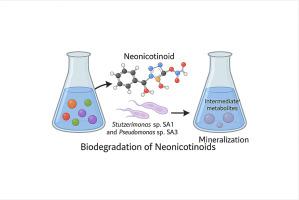新出现的污染物新烟碱类的生物降解途径及机理
IF 6.3
2区 环境科学与生态学
Q1 ENVIRONMENTAL SCIENCES
引用次数: 0
摘要
新烟碱类农药(Neonicotinoids, NEOs)是第四代农药,广泛应用于农业作物保护。然而,它们的过度使用会对环境和人类健康产生负面影响。生物降解为消除这些杀虫剂提供了一种环保的方法。本研究利用从农药污染的农业土壤中分离到的Stutzerimonas sp. SA1和Pseudomonas sp. SA3菌株,降解对乙酰虫脒(AC)、吡虫啉(IM)、噻虫嗪(TH)和噻虫苷(CL)等多种neo。在生物降解过程中检测到许多中间化合物,并讨论了可能的途径。在Stutzerimonas sp. SA1和Pseudomonas sp. SA3中,clothianidin和acetamiprid的化学需氧量降低率最高,分别为87% %和72% %。细菌联合体通过分泌腈水合酶(NH)有效地分解neo。傅里叶变换红外光谱结果证实了近地天体残留物中存在烷烃和羰基官能团。气相色谱-质谱分析结果表明,Stutzerimonas sp. SA1具有最高的生物降解效率(BE) AC(89 %)和IM(87 %)。假单胞菌sp. SA3在AC(90 %)、IM(97 %)和TH(85 %)中的BE高于Stutzerimonas sp. SA1。结果表明,这些细菌可以有效地产生降解酶,并利用neo作为碳源。结果表明,这些细菌产生NH降解酶,并利用neo作为碳源。综上所述,菌株Stutzerimonas sp. SA1和Pseudomonas sp. SA3被确定为生物矿化和去除neo污染环境的潜在候选菌株。本文章由计算机程序翻译,如有差异,请以英文原文为准。

Biodegradation pathway and mechanism of new emerging pollutants neonicotinoids
Neonicotinoids (NEOs), a fourth-generation pesticide group, are extensively utilized for crop protection in agriculture. However, their excessive use can negatively impact the environment and human health. Biodegradation offers an eco-friendly method for eliminating these insecticides. This study employed bacterial strains Stutzerimonas sp. SA1 and Pseudomonas sp. SA3, isolated from pesticide-contaminated agricultural soil, to degrade the various NEOs including acetamiprid (AC), imidacloprid (IM), thiamethoxam (TH), and clothianidin (CL). Numerous intermediate compounds were detected during biodegradation, and potential pathways were discussed. The highest reduction of chemical oxygen demand of clothianidin (87 %) and acetamiprid (72 %) were observed in Stutzerimonas sp. SA1 and Pseudomonas sp. SA3 were AC 72 % and CL 66 % respectively. A bacterial consortium effectively breakdown the NEOs through the secretion of nitrile hydratase (NH) enzyme. Fourier-transform infrared spectroscopy results confirmed the presence of functional groups alkane and carbonyl in the NEOs residue. The Gas Chromatography Mass Spectrometry data revealed that the Stutzerimonas sp. SA1 has the highest potential of biodegradation efficiency (BE) AC (89 %) and IM (87 %) than the other NEOs respectively. The Pseudomonas sp. SA3 shoved the higher BE in the AC (90 %), IM (97 %) and TH (85 %) than the bacterium Stutzerimonas sp. SA1. The results suggest that these bacteria produce the degradative enzymes effectively and utilize the NEOs as a carbon source. The results suggest that these bacteria produce the NH degradative enzymes and utilize the NEOs as a carbon source. In conclusion, the strains Stutzerimonas sp. SA1 and Pseudomonas sp. SA3 were identified as potential candidate for the biomineralization and removal of NEOs contaminated environment.
求助全文
通过发布文献求助,成功后即可免费获取论文全文。
去求助
来源期刊

Journal of Environmental Sciences-china
环境科学-环境科学
CiteScore
13.70
自引率
0.00%
发文量
6354
审稿时长
2.6 months
期刊介绍:
The Journal of Environmental Sciences is an international journal started in 1989. The journal is devoted to publish original, peer-reviewed research papers on main aspects of environmental sciences, such as environmental chemistry, environmental biology, ecology, geosciences and environmental physics. Appropriate subjects include basic and applied research on atmospheric, terrestrial and aquatic environments, pollution control and abatement technology, conservation of natural resources, environmental health and toxicology. Announcements of international environmental science meetings and other recent information are also included.
 求助内容:
求助内容: 应助结果提醒方式:
应助结果提醒方式:


